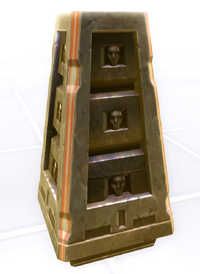Tulpaa was an Unknown Regions planet. It was located in the Rakatan Archipelago, a group of worlds settled by remnants of the collapsed Infinite Empire of the Rakata species. During the subsequent tens of millennia, the Rakatan tribes inhabiting Tulpaa and its fellow planet Makatak emerged as the most advanced of the Rakatan Archipelago worlds.
The Tulpaa and Makatak tribes both sent recovered Infinite Empire skipships to search for exploitable resources and slaves on life-rich Unknown Regions planets. The emerging Force-sensitivity of Tulpaa's Elder Ruthic also facilitated the tribe's insight into other Force-powered technological artifacts of the Infinite Empire such as mind prisons. Additionally, Tulpaa attempted to complete the construction of a Star Forge orbital factory, an effort in which the planet competed with Makatak.
Description[]
A terrestrial planet, Tulpaa[2] was located in the Unknown Regions star system of the same name.[1] It was a part of the Rakatan Archipelago, a fragmented group of unaligned planets that stretched across the entirety of the Unknown Regions.[2]
History[]
An advanced remnant[]

Tulpaa was inhabited by a tribe of the Rakata species.
Tulpaa was settled by one of the tribes of the Rakata species fleeing the collapse of the Rakatan Infinite Empire[2] around 25,200 BBY.[3] Due to the plague that led to the empire's downfall, the surviving Rakata lost their natural sensitivity to the Force, thereby rendering much of their advanced Force-powered technology inoperable. As a result, the worlds of the Rakatan Archipelago regressed to a primitive state.[2]
During the subsequent tens of millennia, Tulpaa and the planet Makatak both became home to the most technologically advanced Rakata in the Unknown Regions. The priests, also known as the Elders, of both the Tulpaa and Makatak tribes eventually exhumed buried Rakatan starships known as skipships, thereby regaining interstellar spaceflight ability.[2]
The hyperspace drives of the skipships operated by zeroing in on planets with rich biospheres that had high concentrations of the Force, and the Force-dependent nature of the technology meant that the Rakatan tribes were unable to control the process. Another effect of the skipships' operating principles was that Tulpaa and Makatak came to compete over the same life-rich worlds, from which the Rakata harvested slaves and natural resources such as metals and ores, compressed gasses, and radioactive plasma.[2]
Mind prisons[]

The Tulpaa tribe possessed dozens of mind prisons.
The Rakatan Elders on Makatak and Tulpaa tinkered with other crumbling inventions of the Infinite Empire, as well. Both tribes possessed dozens of mind prisons, ancient boxes that each contained an infinite expanse of white nothingness and that were used as prison devices. The Rakata on Tulpaa and Makatak attempted to puzzle out a way to unlock the mind prisons; however, since such a feat could only be performed via use of the Force, the technology remained beyond their reach.[2]
At some point, Elder Ruthic—who, uniquely among the Rakata, over the years had been gradually developing a connection to the Force—exiled her rivals among the Tulpaa tribe's leadership into a mind prison and herself became the head of the tribe. Ruthic's growing Force-sensitivity gave her tribe a significant advantage due to the insight she gained into the Infinite Empire's technology. As a result, skipships were dispatched from Tulpaa by the hundreds to scour the Unknown Regions for slaves and resources.[2]
A new Star Forge[]
In addition, Tulpaa and Makatak were competing to complete the construction on half-kilometer-large scaled-down versions of the Star Forge,[2] an orbital factory[4] that was powered by the dark side of the Force[5] and was capable of nearly-infinite output[4] of warships and battle droids.[6] By the time of Ruthic's leadership, the metal skeleton of the new Star Forge was taking shape in the skies of Tulpaa. Raspir, a Sith magician who was released from the same mind prison Ruthic exiled her opponents to and subsequently resided in the Force-sensitive Elder's ruling temple, provided Ruthic with wise advice that allowed her to bend the manufacturing facilities of the Tulpaa Star Forge to her will.[2]
At some point, a group of individuals targeted for sabotage the Star Forge under construction over Tulpaa. In another instance, a Force-sensitive individual helped the Rakata of one of the Makatak and Tulpaa tribes to open a mind prison. The device then released long-imprisoned, unhinged killers, such as criminals of the Sharu species and Kwa super-soldiers.[2]
Inhabitants[]
Tulpaa was inhabited by a tribe of the Rakata, a sentient humanoid species that spoke the Rakata language. The tribe was among the more enlightened Rakatan societies that survived the collapse of the Infinite Empire, especially when compared with the more primitive and barbarous Rakatan worlds of Fitomp and Hilak. In comparison to those planets, Tulpaa saw less day-to-day bloodshed, but the innate, violent conqueror nature of the Rakata, coupled with the species' longing for its lost Force-sensitivity, maintained the powerful desire of the Tulpaa tribe to restore the former glory of the Infinite Empire.[2]
In addition to the Rakata, Tulpaa was home to members of the Gengh-Noghri, an offshoot of the Noghri species[2] that was native to the Outer Rim Territories planet Honoghr.[4] The Gengh-Noghri were brought to Tulpaa from the slave stock the Infinite Empire had drawn from Honoghr, and two members of the subspecies served as bodyguards of Tulpaa's Elder Ruthic.[2]
Behind the scenes[]
Tulpaa was introduced in The Unknown Regions, a sourcebook for the Star Wars Roleplaying Game that was developed by Wizards of the Coast. The Unknown Regions was written by Sterling Hershey, Rodney Thompson, and Daniel Wallace, and was published in 2010. The book includes several adventure seeds for use with the Star Wars Roleplaying Game. This article assumes full completion of those scenarios.[2]
Sources[]
- The Unknown Regions (First mentioned)
Notes and references[]
- ↑ 1.0 1.1 1.2
 Star Wars: The Essential Atlas Online Companion on StarWars.com (article) (backup link) — Based on corresponding data for Tulpaa system
Star Wars: The Essential Atlas Online Companion on StarWars.com (article) (backup link) — Based on corresponding data for Tulpaa system
- ↑ 2.00 2.01 2.02 2.03 2.04 2.05 2.06 2.07 2.08 2.09 2.10 2.11 2.12 2.13 2.14 2.15 2.16 2.17 2.18 2.19 2.20 2.21 2.22 2.23 The Unknown Regions
- ↑ The New Essential Chronology
- ↑ 4.0 4.1 4.2 The Essential Atlas
- ↑ The Complete Star Wars Encyclopedia, Vol. III, p. 76 ("Rakata")
- ↑ The Complete Star Wars Encyclopedia, Vol. III, p. 187 ("Star Forge")
